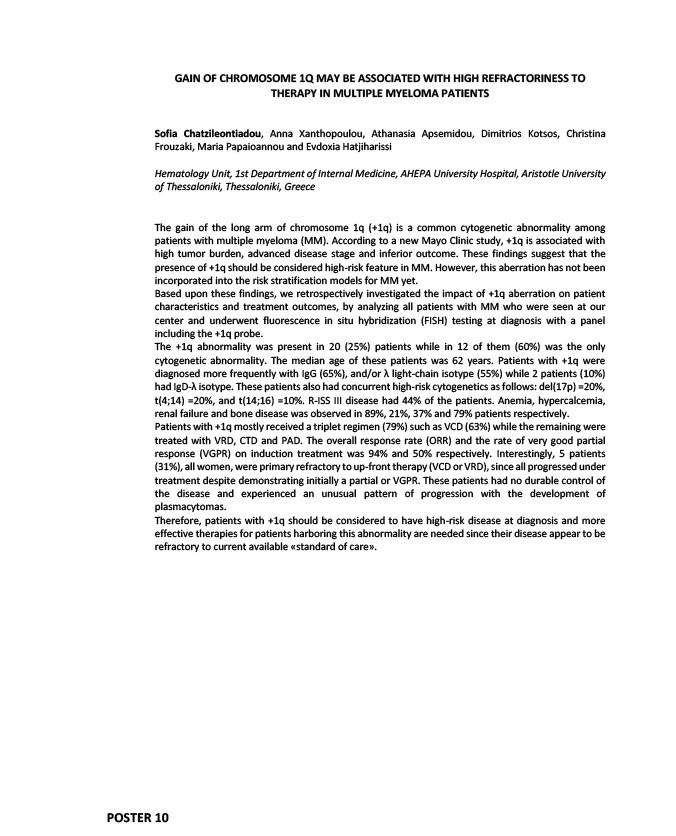
POSTER 10
GAIN OF CHROMOSOME 1Q MAY BE ASSOCIATED WITH HIGH REFRACTORINESS TO
THERAPY IN MULTIPLE MYELOMA PATIENTS
Sofia Chatzileontiadou, Anna Xanthopoulou, Athanasia Apsemidou, Dimitrios Kotsos, Christina
Frouzaki, Maria Papaioannou and Evdoxia Hatjiharissi
Hematology Unit, 1st Department of Internal Medicine, AHEPA University Hospital, Aristotle University
of Thessaloniki, Thessaloniki, Greece
The gain of the long arm of chromosome 1q (+1q) is a common cytogenetic abnormality among
patients with multiple myeloma (MM). According to a new Mayo Clinic study, +1q is associated with
high tumor burden, advanced disease stage and inferior outcome. These findings suggest that the
presence of +1q should be considered high-risk feature in MM. However, this aberration has not been
incorporated into the risk stratification models for MM yet.
Based upon these findings, we retrospectively investigated the impact of +1q aberration on patient
characteristics and treatment outcomes, by analyzing all patients with MM who were seen at our
center and underwent fluorescence in situ hybridization (FISH) testing at diagnosis with a panel
including the +1q probe.
The +1q abnormality was present in 20 (25%) patients while in 12 of them (60%) was the only
cytogenetic abnormality. The median age of these patients was 62 years. Patients with +1q were
diagnosed more frequently with IgG (65%), and/or λ light-chain isotype (55%) while 2 patients (10%)
had IgD-λ isotype. These patients also had concurrent high-risk cytogenetics as follows: del(17p) =20%,
t(4;14) =20%, and t(14;16) =10%. R-ISS III disease had 44% of the patients. Anemia, hypercalcemia,
renal failure and bone disease was observed in 89%, 21%, 37% and 79% patients respectively.
Patients with +1q mostly received a triplet regimen (79%) such as VCD (63%) while the remaining were
treated with VRD, CTD and PAD. The overall response rate (ORR) and the rate of very good partial
response (VGPR) on induction treatment was 94% and 50% respectively. Interestingly, 5 patients
(31%), all women, were primary refractory to up-front therapy (VCD or VRD), since all progressed under
treatment despite demonstrating initially a partial or VGPR. These patients had no durable control of
the disease and experienced an unusual pattern of progression with the development of
plasmacytomas.
Therefore, patients with +1q should be considered to have high-risk disease at diagnosis and more
effective therapies for patients harboring this abnormality are needed since their disease appear to be
refractory to current available «standard of care».